San Luis Province
San Luis (Spanish pronunciation: [san ˈlwis]) is a province of Argentina located near the geographical center of the country (on the 32° South parallel). Neighboring provinces are, from the north clockwise, La Rioja, Córdoba, La Pampa, Mendoza and San Juan.
San Luis
Provincia de San Luis | |
|---|---|
| Province of San Luis | |
 | |
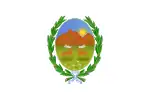 Flag 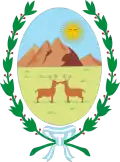 Coat of arms | |
-2.svg.png.webp) | |
| Country | Argentina |
| Capital | San Luis |
| Divisions | 9 departments |
| Government | |
| • Governor | Alberto Rodríguez Saá (CF/FDT) |
| • Senators | María Eugenia Catalfamo, Adolfo Rodríguez Saá, Gabriela González Riollo |
| Area | |
| • Total | 76,748 km2 (29,633 sq mi) |
| Population (2022 census[2]) | |
| • Total | 540,905 |
| • Rank | 19th |
| • Density | 7.0/km2 (18/sq mi) |
| Demonym | Puntano |
| Time zone | UTC−3 (ART) |
| ISO 3166 code | AR-D |
| HDI (2021) | 0.843 very high (10th)[3] |
| Website | sanluis |
History
The city of San Luis was founded in 1594 by Luis Jufré de Loaysa y Meneses, but was subsequently abandoned. It was refounded by Martín García Óñez de Loyola in 1596 under the name San Luis de Loyola.[4]
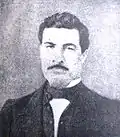
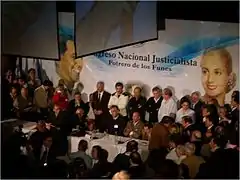
Since the return of Argentina to democratic rule in 1983, in particular, the Rodríguez Saá family (of Peronist affiliation) has occupied the governor's seat. Governor (now Senator) Adolfo Rodríguez Saá has overseen investment by light manufacturers (mostly food-processors and bottling plants) and advances like the construction of Argentina's most extensive expressway network.[5]
Economy
San Luis' economy has, over the past generation, been among the most improved in Argentina. Its 2006 output, estimated at US$3.386 billion, yielded a per capita income of US$9,203 (somewhat above the national average).[6]
Demographics
Historical evolution of the population of the province:
|
|
Government
.jpg.webp)
The provincial government is divided into three branches: the executive, headed by a popularly elected governor, who appoints the cabinet; the legislative; and the judiciary, headed by the Supreme Court.
Political division
The province is divided into nine departments (departamentos).
%252C_departments_and_capital.png.webp)
| Department | Capital |
|---|---|
| Ayacucho | San Francisco del Monte de Oro |
| Belgrano | Villa General Roca |
| La Capital | San Luis |
| Chacabuco | Concarán |
| Coronel Pringles | La Toma |
| General Pedernera | Villa Mercedes |
| Gobernador Dupuy | Buena Esperanza |
| Junín | Santa Rosa |
| Libertador General San Martín | Libertador General San Martín |
Source for department names:[14]
Villages
References
- "San Luis (Province, Argentina)". Encyclopaedia Britannica. Retrieved 23 March 2020.
- "Nuevos datos provisorios del Censo 2022: Argentina tiene 46.044.703 habitantes". Infobae. 31 January 2023. Retrieved 2023-02-03.
- "El mapa del desarrollo humano en Argentina" (PDF). United Nations Development Programme. 25 June 2023.
- "PROVINCIA DE SAN LUIS" (in Spanish). El Vigía. Retrieved 1 April 2013.
- Grupo Payne Archived May 31, 2011, at the Wayback Machine
- "El déficit consolidado de las provincias rondará los $11.500 millones este año" (in Spanish). Instituto Argentino para el Desarrollo de las Economías Regionales. Archived from the original on July 11, 2015. Retrieved 10 July 2015.
- Sonia Tell (2008), Córdoba rural, una sociedad campesina (1750-1850), Buenos Aires: Prometeo Libros Editorial, pp, 55 (nota n°32), ISBN 978-987-574-267-3,
- Reynaldo Pastor (1970), San Luis, Su gloriosa y callada gesta, 1810-1867, Ciudad de San Luis, pp, 33
- Sir Woodbine Parish (1853), Buenos Aires y las provincias del Rio de la Plata: desde su descubrimiento y conquista por los Españoles, Tomo II, Buenos Aires: Imprenta de Mayo, pp, 229
- Sir Woodbine Parish, 1853: 450
- Laura Marcela Méndez (2007), Las Efemérides En El Aula, Buenos Aires: Noveduc Libros, pp, 204, ISBN 987-538-125-X,
- Mariela Ceva, Alejandro Fernández, Aníbal Jáuregui & Julio Stortini (2000), Historia Social Argentina En Documentos, Buenos Aires: Editorial Biblos, pp, 108, ISBN 950-786-245-5,
- Argentina: población total por regiones y provincias, Censos Nacionales de 1914, 1947, 1960, 1970, 1980,1991 y 2001
- "Argentina: San Luis". City Population. Retrieved 5 October 2012.
External links
 Media related to San Luis Province at Wikimedia Commons
Media related to San Luis Province at Wikimedia Commons- Provincia de San Luis - Official website (in Spanish)
- Argentour: San Luis Province
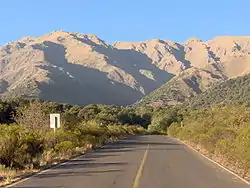 Landscape near Merlo.
Landscape near Merlo. Expressway south of the city of San Luis. The province's highway network is among the most developed in Argentina.
Expressway south of the city of San Luis. The province's highway network is among the most developed in Argentina.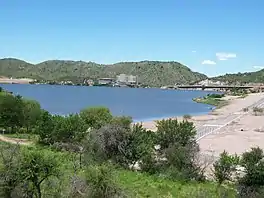 Lake Potrero de los Funes
Lake Potrero de los Funes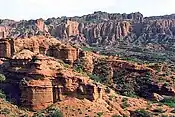 Canyon in the Sierra de las Quijadas.
Canyon in the Sierra de las Quijadas.